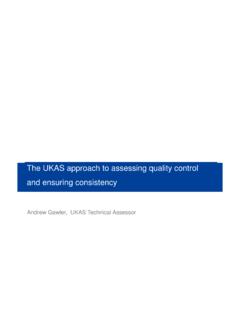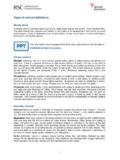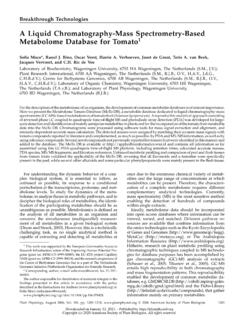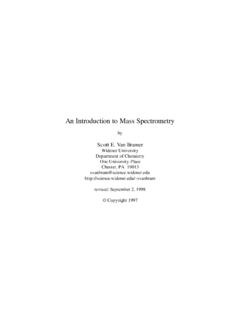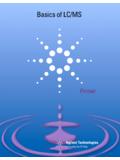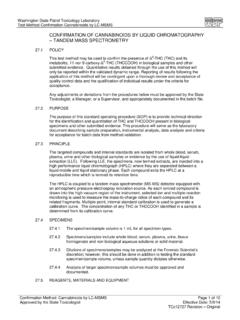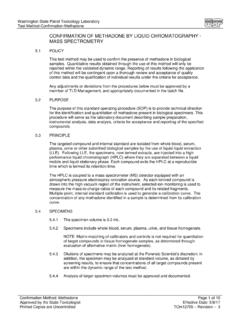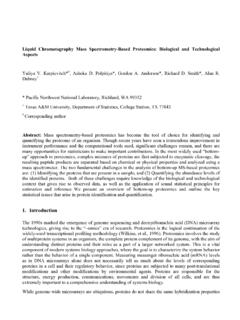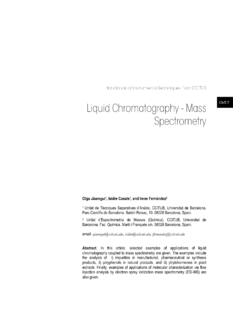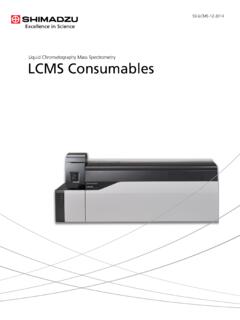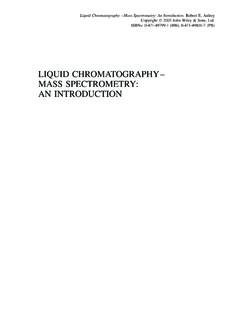Transcription of High-performance liquid chromatography/mass …
1 LCMS\TBv31of 2 Royal Society of Chemistry 2008 ISSN 1757-5958amc technical briefsEditor: Michael ThompsonAnalytical Methods CommitteeAMCTB34 November 2008 High-performance liquid chromatography / mass spectrometry (LC/MS) mass spectrometry (MS) provides us with uniquelyvaluable information: molecular mass (via mass tocharge(m/z)ratio); molecular structural informationand quantitative data, all at high ,it is best to apply separation techniques to complexmixtures before mass spectrometry is liquid chromatography (LC) isexcellentfor separating mixtures but generally poor atidentification of compounds. Thecombination of thesetwo techniques (LC/MS)thusprovides the marriage of MS and LC was uneasy and manyinterfaceshave beentried over the last 20 the relationship is more harmonious,thanks tothe development of electrospray ionisation, the best meanscurrently available for transferring molecules from solutioninto the gas phase for MS InstrumentationFigure 1 shows a schematic diagram of a massspectrometer linked to LC.
2 The mass spectrometerseparates the ionised molecules that have been transferredto the gas phase, after desolvation of the LC eluent. Thetransfer takes place in the interface and may occur atatmospheric pressure or in vacuum, depending on the typeof ionisation employed. Ions are then separated on thebasis of their mass and charge (m/z) at high vacuum in themass analyser. There are currently about 60differentmassspectrometers on the market, available from about a dozenmanufacturers, withvariousionisation methods, massanalysers and detectortypes,andawide range of of ionisationThe coupling of LC with mass spectrometers has been animportant development and continues to began in the early 1970s and involvedtechniquesforevaporatingsolventa ndsplittingthe flowfrom LC columns to admit eluted compounds into the highvacuum of the ,it was not until1987 and the commercialisation of atmospheric pressureionisation (API)
3 That LC/MS became sources at vacuum(such as thermospray,particle-beam and continuous-flow fast atombombardment)are still in use, but API interfaces are by farthe most widely used, being the most inherently suitable forLC/MS coupling. API involves soft ionisation, producinglittle fragmentation of molecules so providing molecularweight information. However, fragmentation may beinduced subsequently to obtain molecular structuralinformation. There arethreemain API techniques,electrospray ionisation (ESI), atmospheric pressurechemical ionisation (APCI) and the relatively newtechnique of atmospheric pressure photo-Figure diagram ofmass spectrometer linked to (APPI).
4 Figure 2 shows the applicability ofthese ionisation techniquesforanalytes of different polarityand molecular weight. Gas chromatography /MS (GC/MS)is included for of ionisationtechniquestomolecules ofvarious polaritiesand molecular most widely used in LC/MS and ions are usuallyformed by protonation of molecules in positive mode anddeprotonation in negative mode, the choice being dictatedby the characteristics of the analyte. However, some MSinstruments can rapidly switch between modes in alternatescans. In ESI, ionised droplets are produced by applying ahigh voltage (typically 3-5kV) to the outlet of acapillarycarrying the LC eluent.
5 A fine mist of charged droplets isproduced at atmospheric pressure, aided by nebulisationwith nitrogengaswhich is alsousedas a drying gastogether with source heating to de-solvate the droplets. Thede-solvated ionsare guided through skimmers into thehigh vacuum region of the mass analyser by application ofelectric fields. Nanospray , a development ofelectrospray, uses flow rateslowerthanmicrolitres perDETECTORSOURCEIONISATIONLCSYSTEMCOMPU TERMASSANALYSERION SEPARATIONCOMPUTERMASS SPECTRUMMASS SPECTROMETERMASS CHROMATOGRAMNONPOLARVERYPOLARMOLECULARWE IGHT100100010,000 ESIAPCIGC/MSAPPI100,000amcLCMS\TBv32of 2 Royal Society of Chemistry 2008minute, with a narrowercapillaryoutlet, providing smallerdroplets and more efficient ionisation.
6 Multiple sprayers(2-8) may be used in either technique: independent liquidstreams are fed into the MS source and sampledsequentially into the mass analyser. This allows couplingof up to 8 LC systems intoone mass spectrometer and theuse of a standard reference solutionfor accurate massmeasurementwith high resolution instruments(todetermineempirical formulae). ESI flow rates range fromnL/min to about 200 L/min and response is dependent onthe concentration of analyte rather than amount, allowinguse ofmicrobore and capillary columns, or even chip-basedLC. With larger columns the best performance is obtainedby splitting the flow via a simple T-piece.
7 Capillaryelectrophoresis and electro- chromatography may also belinked to is a development of ESI, in which the LC eluent israpidly evaporated on passing through a nebuliser at hightemperature. Ionisation is produced by corona discharge inthe spray and solvent ions are produced that can react withthe analytes in the gas phase (chemical ionisation). Higherflow rates of ml min-1can be used and a greater degree offragmentation takes place. APPI is a newer techniquewhich is reported to have fewer matrix effects than ESI orAPCI. LCeluent is sprayed with a nebulising gas into aheated probe, as in APCI, and a dopant compound isvaporised and ionised by UV radiation, forming photo-ions.
8 The photo-ions initiate a cascade of ion-moleculereactions, forming ionised isgenerally most suitable for relatively polarmolecules, across a wide range of molecular mass , whileAPCI and APPI are most suitable for small (less than 1000Da) relatively non-polar analysersThe type of mass analyser defines the there are sector instruments relying on magnetic andelectric fields form/zion separation, quadrupoleinstruments usingradio frequency and DC voltage, therelated ion-traps,and measurement of ion flight time intime-of-flight (TOF)analysers. It is beyond the scope ofthis technical brief to describe these in more detail, but allhave advantages and disadvantages in coupling with LC, inrespect of cost, data acquisition rate, resolution, sensitivityetc.
9 Sector instruments are difficult to couple with LC forseveral reasons, but the other analysers are well representedin LC/MS are other instruments,including FTICR (Fourier transform ion cyclotronresonance) and the Orbitrap , but these are not analysers may be coupled serially to provide a varietyof tandem MS/MS experiments, including fragmentation ofa selected ion from the first mass analyser by collision withan inert gas in a collision cell, as shown schematically inFigure 3. In tandem MS/MS, separation of the fragmentsfrom the selected precursor ion occurs in the second massanalyser, with the resulting product ion spectrum providingstructural information.
10 There are several other MS/MSexperiments possible, including precursor ion scans,constant neutral loss scans, and single and multiple reactionmonitoring, but describing these is beyond the scope of thisbrief. Similar or different mass analysers may be coupledfor various reasons, for example, quadrupole/quadrupoleand quadrupole/TOF are popular combinations forLC/MS/MS. Ion-traps are able to perform multiple massspectrometry (MSn) experiments within the space of thetrap, rather than MS/MS in time. Quadrupole and ion-trapinstruments are currently most common in LC/MS, butthere is a trend towards the use of TOF MS/MS mass SpectrometerApplications of LC/MSApplications of LC/MS cover a vast range, often involvingquantification as well as molecular structuralstudies, andinclude studies in drug metabolism,clinical chemistry,natural products, trace contaminants in food and theenvironment, chemical synthesis structure confirmation,and many others.

